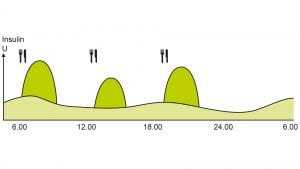
Diabetes care specialists, Ypsomed outline the advantages of insulin pump therapy for people with type 1 and type 2 diabetes.
Insulin plays a key role in metabolism: This hormone alone enables sufficient glucose (sugar) to be transported from the blood into the body’s cells, where it is converted into energy.
In the case of people with type 1 diabetes the pancreas no longer produces insulin. It must be supplied by means of insulin therapy. Insulin therapy may also be necessary in the case of type 2 diabetes, if prescribed by a healthcare professional.
Basics of the therapy
In order to ensure that treatment involving insulin therapy is effective, it is important to understand the following:
- The body requires a continuous supply of insulin in order to maintain all bodily functions.
- Additional insulin is required by the body at mealtimes; the quantity depends on the amount of carbohydrates consumed.
Insulin therapy for people with type 1 diabetes
The two most common forms of insulin therapy for people with type 1 diabetes are:
Multiple Daily Injections (MDI) with insulin pens: Injections of long-acting insulin once or twice daily and short-acting insulin (injections) in the fatty tissue around mealtimes, as needed.
- Insulin pump therapy (CSII – Continuous Subcutaneous Insulin Infusion): With this therapy, an insulin pump continuously supplies the body with its basic insulin requirements. The additional insulin required at mealtimes is administered by pressing a button. The insulin is administered from the insulin pump via a cannula into the fatty tissue.
Blood glucose levels are personally measured several times each day with a blood glucose meter (BGM) or constantly with Continuous Glucose Monitoring (CGM). These values form the basis for calculating mealtime insulin and any correction insulin.
Insulin therapy for people with type 2 diabetes
For people with type 2 diabetes, one of the following therapies is often selected to start the patient on insulin therapy. These therapies involve insulin being injected into the fatty tissue with an insulin pen:
- Basal-supported oral therapy with a long-acting insulin and tablets.
- Supplementary insulin therapy with a short-acting insulin and tablets.
- Conventional therapy with a mixture of short- and fast-acting insulin.
Insulin pen therapy – Intensive conventional therapy (ICT)
In this therapy, the insulin is injected at least four times each day with an insulin pen.
Two types of insulin are used here:
- A long-acting insulin (“basal insulin” or “delayed-action insulin”) that is injected once or twice each day in order to meet the body’s basic requirements.
- A short-acting insulin (“bolus insulin”) that is injected at each mealtime and in order to correct elevated blood glucose levels.
An insulin pen contains an insulin ampoule and a dosing device. Two different pens are used for the basal and bolus insulin. The insulin is injected into the subcutaneous fatty tissue under the skin (subcutaneous) on the abdomen, thighs or buttocks. The pen needles used are extremely thin, so the injection is barely noticeable. The pen needle is replaced after each injection. Intensive conventional therapy (ICT) is the standard therapy for most people with type 1 diabetes. However, it has its limits.
- Blood glucose levels may be too high when you wake up in the morning (the “dawn phenomenon” or “daybreak phenomenon”). This is caused by changes in insulin requirements during the night, which cannot be covered with long-acting, delayed-action insulin.
- Delayed-action insulin provides little flexibility. If the insulin requirements change suddenly, for example during physical activity/sports or in stressful situations, the body is unable to respond to these changes quickly.
- It is difficult to manage irregular daily routines and shift work with delayed-action insulin because the basic insulin requirements are constantly fluctuating.
- In children and adolescents, as well pregnant women, ICT is often unable to provide satisfactory control of blood glucose levels due to hormonal fluctuations.
In these cases therapy with insulin pumps is a good alternative.
Insulin pump therapy – Continuous Subcutaneous Insulin Infusion (CSII)
With this therapy, an insulin pump supplies the body continuously with its basic insulin requirements. The additional insulin required at mealtimes is administered by pressing a button. An important difference to therapy with the insulin pen is that short-acting insulin only is used to cover both the body’s basic requirements, as well as the insulin required at mealtimes.
Whereas, an insulin pump is worn on the body. In order to ensure adequate insulin pump therapy, the insulin pump settings must be adjusted to meet the insulin requirements of each individual, and these settings must be checked regularly by measuring blood glucose levels.
A conventional insulin pump with a tube, like the mylife YpsoPump can be worn on your belt, for example. Insulin reaches the body via an infusion set with a tube whose cannula has been inserted into the fatty tissue under the skin.
Compared with Multiple Daily Injections (MDI) insulin pump therapy has the following advantages, including:
- It is no longer necessary to administer frequent injections with the insulin pen because the cannula of the insulin pump remains inserted in the skin for up to three days.
- The insulin pump provides an insulin supply that is similar to that of non-diabetics
- The ability to adjust the insulin supply to the needs of each individual can reduce the occurrence of elevated blood glucose levels in the morning (the dawn phenomenon) or frequent hypoglycaemic episodes.
- The use of short-acting insulin only provides for a high level of flexibility during athletic activity, at mealtimes, and when you want to have a lie-in.
- It is easier to manage irregular daily routines and shift work with insulin pump therapy because your insulin requirements can be covered exclusively with individually adjusted doses of short-acting insulin.
Insulin “release” with insulin pump therapy (CSII)
Insulin “release” with insulin pump therapy compared with insulin release in non-diabetics: The insulin administered with an insulin pump is very similar to insulin release in non-diabetics.







